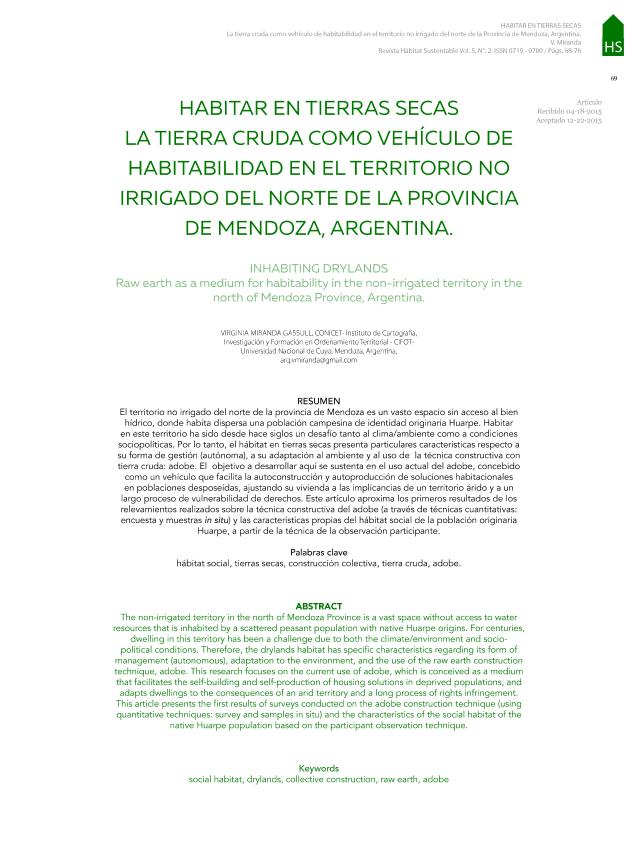Artículo
El territorio no irrigado del norte de la provincia de Mendoza es un vasto espacio sin acceso al bien hídrico donde habita dispersa una población campesina de identidad originaria Huarpe. Habitar en este territorio ha sido desde hace siglos un desafío tanto al clima/ambiente como a condiciones sociopolíticas. Por lo tanto, el hábitat en tierras secas presenta particulares características respecto a su forma de gestión (autogestionadas), a su adaptación al ambiente y al uso de la técnica constructiva con tierra cruda: adobe. El objetivo a desarrollar se sustenta en el uso actual del adobe, concebido como un vehículo que facilita la autoconstrucción y autoproducción de soluciones habitacionales en poblaciones desposeídas, ajustando su vivienda a las implicancias de un territorio árido y a un largo proceso de vulnerabilidad de derechos. Este artículo aproxima los primeros resultados de los relevamientos realizados sobre la técnica constructiva del adobe (técnicas cuantitativas: encuesta y muestras in situ) y las características propias del hábitat social de la población originaria Huarpe a partir de la técnica de la observación participante. The non-irrigated territory in the north of Mendoza Province is a vast space without access to water resources that is inhabited by a scattered peasant population with native Huarpe origins. For centuries, dwelling in this territory has been a challenge due to both the climate/environment and sociopolitical conditions. Therefore, the drylands habitat has specific characteristics regarding its form of management (autonomous), adaptation to the environment, and the use of the raw earth construction technique, adobe. This research focuses on the current use of adobe, which is conceived as a medium that facilitates the self-building and self-production of housing solutions in deprived populations, and adapts dwellings to the consequences of an arid territory and a long process of rights infringement. This article presents the first results of surveys conducted on the adobe construction technique (using quantitative techniques: survey and samples in situ) and the characteristics of the social habitat of the native Huarpe population based on the participant observation technique.
Habitar en Tierras Secas: La Tierra Cruda como vehículo de habitabilidad en el territorio no irrigado del norte de la Provincia de Mendoza, Argentina
Título:
Inhabiting drylands: Raw earth as a medium for habitability in the non-irrigated territory in the north of Mendoza Province, Argentina
Fecha de publicación:
12/2015
Editorial:
Universidad del Bío-Bío. Facultad de Arquitectura, Construcción y Diseño
Revista:
Hábitat Sustentable
ISSN:
0719-0700
Idioma:
Español
Tipo de recurso:
Artículo publicado
Clasificación temática:
Resumen
Palabras clave:
Hábitat social
,
Construcción colectiva
,
Tierra cruda
,
Adobe
,
Tierras secas
Archivos asociados
Licencia
Identificadores
Colecciones
Articulos(CCT - MENDOZA)
Articulos de CTRO.CIENTIFICO TECNOL.CONICET - MENDOZA
Articulos de CTRO.CIENTIFICO TECNOL.CONICET - MENDOZA
Citación
Miranda Gassull, Virginia Paulina; Habitar en Tierras Secas: La Tierra Cruda como vehículo de habitabilidad en el territorio no irrigado del norte de la Provincia de Mendoza, Argentina; Universidad del Bío-Bío. Facultad de Arquitectura, Construcción y Diseño; Hábitat Sustentable; 5; 2; 12-2015; 69-76
Compartir




